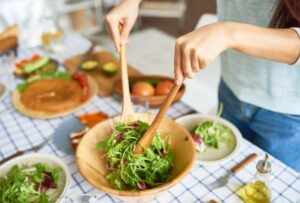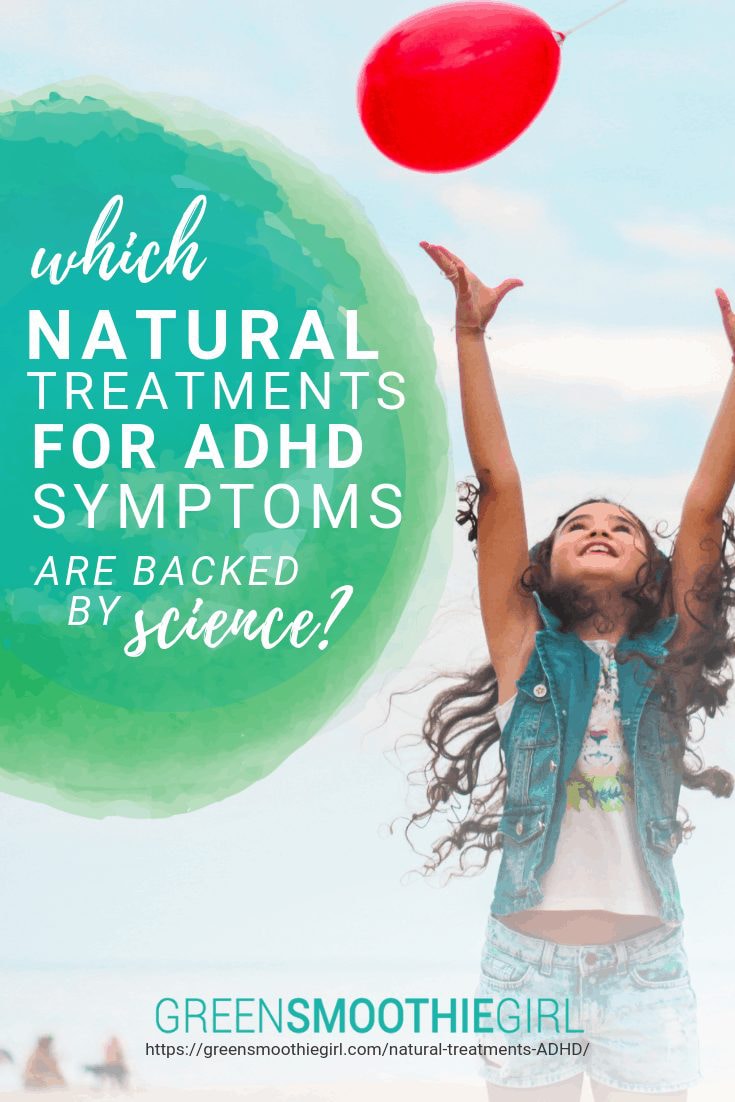Which Natural Treatments for ADHD Symptoms Are Backed by Science?

One of my best friends in junior high was diagnosed with ADHD. What others saw as over-the-top, excessive energy, and the inability to focus, I saw as unique, creative, and near genius. I was right. He became a CEO of an incredible company that has made a huge and positive impact on numerous lives.
I’m wondering what the outcome would have been if he was born into a different family? The doctors wanted to put him on Ritalin. His mother said no.
The school wanted to put him into special-ed classes. His father said no. Instead, being holistically oriented, they changed his diet to whole, unprocessed foods and put him on some probiotic and mineral supplements.
And, maybe just as important as all the above, they loved and appreciated his uniquely high-energy, over-the-top, sometimes bouncing-off-the wall personality.
So, what is ADHD? And are we treating our hyperactive children because it’s bad for them, or because it’s a nuisance for teachers? How many geniuses are we subduing? Let’s dig through the noise, in search of the truth.
In this article:
- ADHD Symptoms
- How ADHD Differs in Girls & Boys
- Why ADHD is Frequently Misdiagnosed
- Traditional ADHD Treatment
- Ritalin's Side Effects
- Adderall's Side Effects
- Research-Based Natural Treatments for ADHD
- Foods to Avoid for ADHD
- Foods that Help Alleviate ADHD
- Green Smoothies and Salads for ADHD
- Herbal Supplements for ADHD
- Helpful Lifestyle Changes for ADHD
- Conclusion
What are the Symptoms of ADHD?
ADHD stands for Attention Deficit/Hyperactive Disorder. It is one of those diseases that is diagnosed based on an individual’s symptoms. Unfortunately, with no corresponding lab tests to validate the diagnosis, it is far too easy to label a child as hyperactive or inattentive and then prescribe meds.
And labeling, they are. This diagnosis increased by 43 percent between 2003 and 2011. Over 6 million children in America are now diagnosed with ADHD.1

The number of kids diagnosed with ADHD has risen dramatically in recent years.
The following represent the criteria for an ADHD diagnosis:
Inattention that has been present for at least six months
Six symptoms must be present which include inability to listen, no follow through on instructions, trouble organizing, losing items, easily distracted, and forgetful.
Hyperactivity and impulsivity that has been present for at least six months to an extent that is disruptive
Six symptoms must again be present, and they include the following: fidgeting, unable to stay seated for long periods, unable to play, runs in inappropriate situations, trouble waiting their turn, and interrupts others.2
ADHD Symptoms Different in Boys vs. Girls
Keep in mind that girls and boys may exhibit different variations of the above symptoms. For instance, boys' symptoms are often external in nature: impulsive, running, physical aggression. Girls, on the other hand, are more apt to internalize their feelings. This leads to symptoms such as low self-esteem, withdrawing from social situations, extreme sensitivity, and being daydreamy.
Why ADHD is Frequently Misdiagnosed
There are many reasons a kid might get diagnosed with ADHD and given prescription drugs, and they all serve interests that are often contrary to the welfare of the child:
Incorrect diagnostics
There are several conditions that mimic the symptoms associated with ADHD.3 These conditions include:
- Trauma such as a divorce or death in the family, or a sudden and unexpected move.
- Thyroid problems.
- Sleep disorders.
- Toxicity from lead and other heavy metals.
- Toxicity from secondhand smoke. Children exposed to tobacco smoke at home are three times more likely to be diagnosed with ADHD.4
The convenience of schools and teachers
Add to that our society’s academic pressures to succeed as defined by a school’s parameters, parents and teachers who are looking for a diagnosis and quick fix, and a culture that values standing in line, sitting at attention, and coloring inside the lines--and you have the perfect storm for over-diagnosing ADHD cases.
Sanford Newmark, a medical doctor practicing in Silicon Valley, reported in Psychiatry Advisor that up to one-third of the children in the area’s schools are taking psychostimulants like Ritalin, Adderall, and Focalin because of the pressure to succeed.5
Several studies have demonstrated that the youngest children in a classroom are 50 percent more likely to be diagnosed with ADHD and prescribed psychostimulants.6,7
What does this statistic tell us? That, quite possibly, these children are put on medication not because they are hyperactive or lack the ability to pay attention, but because they are immature, younger than their peers, and not quite ready for the demands their grade places on them.

In some cases, an ADHD diagnosis is more about the adults in a child's life than the child himself.
The convenience of caregivers
Americans spend about 90 percent of their food budget on processed foods--quick, easy, cheap meals and snacks that don’t require much (if any) preparation.
There are currently 3,000 additives the FDA has approved for use in processed “food.”8 What do you think these chemicals used to preserve, flavor, color and process “food” are doing to the children who eat them?
One of these additives is perchlorate, a substance used in rocket fuel that also impairs the development of an infant’s brain.
Dr. Benjamin Feingold reported in 1973 that hyperactivity and learning problems were due to certain foods and additives. Based on his practice, he believed that many of his patients were sensitive to foods containing natural salicylates, added food coloring, flavors, and preservatives. Feingold reported an improvement of 60 to 70 percent of his pediatric patients that eliminated these neurotoxic additives from their diet.9
[Related: Can You Spot Neurotoxins On Your Food Labels?]
The insatiable growth of the pharmaceutical industry
The two most common drugs used to treat ADHD—Ritalin and Adderall—represent a large part of the $13 billion that pharmaceutical companies make on the sale of ADHD drugs every year. Yes, you read that right…13 billion dollars!
The Traditional Treatment for ADHD
As with most diseases, traditional medicine treats the symptoms, not the cause. The two most commonly prescribed medications that doctors use to treat the symptoms are Ritalin and Adderall. Both of these chemicals increase the levels of dopamine, norepinephrine and serotonin—the “feel good” neurotransmitters that regulate mood and behavior. Both of these chemicals are stimulants.
Keep in mind that the National Institute for Health and Care Excellence states that these drugs should only be prescribed as a last resort.11
Ritalin and its side effects
Ritalin is prescribed to about 6 million people in the United States. 75 percent of these are children. Ritalin has been compared to cocaine, in that it is a powerful stimulant that increases alertness and productivity and has a similar chemical structure.
Short-term side effects of Ritalin include loss of appetite, insomnia, nausea, hallucinations, irritability, psychosis and convulsions. Long-term side effects include permanent damage to the blood vessels of the heart and brain, which may ultimately lead to heart attacks and strokes. Additional side effects include damage to the liver, kidneys and lungs as well as depression.12

Side effects of prescription drugs are important to keep in mind when your child is diagnosed with ADHD.
Adderall and its side effects
Adderall is a highly addictive amphetamine. Street names for this substance include speed, uppers, black beauties, Addys and pep pills. Just a few of the many side effects of Adderall include anxiety, irritability, aggression, delayed growth, and muscle tics. Some children experience emotional swings that range from manic to emotional flat and unresponsive.
According to the International Journal of Risk & Safety in Medicine, “Animal and human research indicates that these drugs often suppress spontaneous and social behaviors while promoting obsessive/compulsive behaviors.”13
I’m not saying that people should NEVER take ADD/ADHD meds like Adderall and Ritalin. If a person actually has an attention disorder, these drugs may help--but the side effects apply nonetheless. But lots of folks abuse these drugs--because they are basically legal street drugs--risking the side effects for no medical reason.
And even if a person does have an attention disorder, and improves behavior and focus by taking these stimulant drugs, what is the ultimate cost in health? If these are the short-term behavioral and physical symptoms, there are likely some long-term disease risks as well.
Research-Based Natural Treatments for ADHD Symptoms
Here’s the good news: Diet, supplements, and lifestyle changes can make a tremendous difference in the lives of children that have been diagnosed (or misdiagnosed) with ADHD.
Let’s take a look at these proven natural remedies for ADHD symptoms, as backed by research:
Diet for ADHD: Foods To Avoid
Sugar and its many disguises
Sugar has been described as “kryptonite for ADHD brains.” And there are many studies to back it up.
One study investigated the effects of sugar in hyperactive children. The amount of sugar consumed directly corresponded with an increase in destructive-aggressive and restless behaviors of children between the ages of 4 and 7 during free play.14
Sugar comes in many disguises with names like cane juice, barley malt, high-fructose corn syrup, and maltose. Avoid them all. And don’t replace them with artificial sweeteners, since these neurotoxic chemicals can also contribute to behavior problems (in addition to the many other health risks associated with them).
[Related post: The Good, Bad, and Ugly in Sugar Alternatives: Which One Should You Use?]

Sugar can be a major trigger for ADHD symptoms.
Artificial dyes, preservatives, and food additives
The real question is, why would anyone want to consume artificial dyes and preservatives? In 2010, the EU changed its labeling laws, requiring products with artificial dye to contain this statement: “May have adverse effect on activity and attention in children.”
The FDA in the U.S., however, has deemed food dye to be safe for consumption. Studies suggest otherwise, however.
One study provided preschoolers with either 20 milligrams of artificial dye mixed with the preservative sodium benzoate, or a placebo. Those that consumed the dye experienced a significant increase in hyperactivity.15 Other neurotoxic additives to avoid include MSG, nitrates, and artificial flavors.
I recently interviewed Dr. Elisa Song, a holistic pediatrician, about the ADHD epidemic. She said, “Kids who have sensory, behavioral, and attention issues are highly sensitive to artificial colors, preservatives, flavors, and sweeteners. Get that out of their diets, because that literally is poison to some of our kids’ brains.”
Food sensitivities and allergens
The most common food allergens include gluten, eggs, soy, dairy, nuts, citrus fruits, and shellfish. Vincent Monastra, Ph.D. recommends that all children be screened for food allergies before doctors put them on medication for ADHD.16
I recommend conducting an elimination diet in order to determine what foods may be triggers for your child. This includes all grains containing gluten such as wheat, rye, barley, durum, spelt, and Kamut.
Diet for ADHD: Foods to Add To The Diet
Next, let’s let’s take a look at all the great foods that give you the nutrients you need to reduce ADHD symptoms and stay focused.
A whole foods diet that consists of at least 50 percent raw food is best. For those that do not currently eat a mostly plant-based diet, you may be saying to yourself, “I think my child might just starve.” Trust me, you’ll be surprised at how well kids adjust to healthier food when you offer a wide variety to find the ones they’ll enjoy. And as they begin to feel better and get the right nutrients for their brain and body, they’re less likely to be as cranky about the changes in diet.
Green Smoothies And Salads For ADHD
I recently wrote a blog post about helping your kids learn to love green smoothies, my favorite way to get massive amounts of good nutrition down the hatch.
Another tactic is to put your kid in charge of making a nightly salad--all my kids took their turns when they were still at home. (Check out some of our favorite recipes--these salads can be a complete meal!) Making a salad the star of your meals will become your child’s bragging rights.
Let kids make salad topping decisions and smoothie choices that include foods like the following:
- Foods high in Omega-3 fatty acids. Omega-3 fatty acids are key regulators of brain neurotransmissions and inflammation. These foods include avocados, dark leafy greens, flaxseed, walnuts and wild-caught salmon. A review of several studies concluded that a diet high in omega-3 fatty acids reduced ADHD symptoms including hyperactivity, impulsivity, and inattention.17
- Foods that are high in B vitamins. B-6 plays a major role in the making of serotonin while B-12 helps regenerate neurons. Deficiencies in this vital nutrient can also cause irritability and fatigue. Top food sources include leafy greens, bananas, potatoes, and organic, grass-fed poultry and beef, and wild-caught salmon.
- Foods high in zinc. Several studies show a deficiency of zinc in children with ADHD. As this mineral is involved in regulating dopamine and norepinephrine, it makes perfect sense. In clinical studies, zinc supplementation significantly improved ADHD symptoms.18 Zinc can be found in beans, seeds, nuts, whole grains, and seafood. Good grains to choose from include wild and brown rice, quinoa, and millet.
- Foods high in probiotics. I’ve talked about the link between gut and brain health and how probiotics can rehabilitate your microbiome, the colonies of beneficial bacteria in the human 35 feet of gastrointestinal tract. Studies confirm that probiotics may have long-term promise for those suffering from ADHD.19 Foods high in probiotics include kefir, kombucha, raw sauerkraut, and yogurt. Be sure to read the label or make your own yogurt as store-bought brands often contain sugar and other additives, and milk products in general can be problematic for kids with ADHD.
- Good fats. The brain is made up of nearly 60 percent fat. Healthy fats, then, are a very important part of a diet designed to reduce ADHD symptoms. Healthy fats include avocado oil, extra-virgin olive oil, and coconut oil.
[Related video: 3 Fats That Hurt, 3 Fats That Heal]
The bottom line on a healthy diet for ADHD: eat foods in their natural state and stay away from processed foods. And, of course, drink your green smoothie, every day!

Get your kids involved with making nutritious salads.
Herbal Supplements for ADHD
While I believe that food is medicine and should be our primary nutrient source, there are several herbal remedies that have been traditionally used to bring the body back into balance.
Here are a few of the top herbs used to treat ADHD:
Rhodiola Rosea (also known as Golden Root)
Studies show that this herb elevates the levels of the three neurotransmitters previously mentioned: serotonin, dopamine and norepinephrine. It has also been shown to reduce mental fatigue, produce antidepressant effects, and improve attention and memory.18
Ginkgo Biloba and American Ginseng
These two herbs have been used in Chinese medicine for thousands of years. When a combination of both herbs was given to children who exhibited ADHD symptoms, up to 74 percent saw improvement.20
Pycnogenol
Made from pine bark, this herb was found to improve hyperactivity and inattention while fostering concentration. It is also rich in polyphenols, which protect brain cells.21
Lifestyle Changes for ADHD
Make exercise fun!
Movement is essential for everyone, but especially for those with ADHD symptoms. Exercise improves dopamine function, making it good for the brain as well as the body. It also promotes a restful night’s sleep, which also reduces the symptoms of ADHD.
Create an environment that allows your child to excel.
It’s important to remember that ADHD has nothing to do with intelligence. Many children that exhibit symptoms associated with ADHD are extremely intelligent and artistically gifted. They may, however, require hands-on or interactive learning tools in order to really thrive. Make sure that their school can offer them this type of environment.
You’ll find that when a child is really interested in the task at hand, their focus increases dramatically. People that are off the charts in intelligence or creativity get bored easily—flitting from one activity to another until something truly inspires them and catches their attention. Sounds a little like ADHD?
ADHD, even when properly diagnosed, is not always a reason to worry. Consider these amazing people who were told by experts that they had ADHD:
Walt Disney, Albert Einstein, Richard Branson, John F. Kennedy, Will Smith, Jim Carrey, Michael Jordan, Simone Biles, Justin Timberlake, and Michael Phelps.
The Bottom Line On ADHD
- Many doctors believe that ADHD is both overdiagnosed and overtreated.
- Ritalin and Adderall, the two main drugs used in the treatment of ADHD, are stimulants with multiple side-effects.
- There are natural remedies that research demonstrates can truly make a difference in the lives of people with the symptoms of ADHD. These include adopting a whole-foods, mostly plant-based diet and an exercise routine that’s enjoyable and sustainable. Supplements such as herbal remedies have proven to be effective. And, of course, finding passions to devote all that energy to.
Read next: How to Fight Depression and Anxiety: 12 Nutrition Strategies

Disclosure: This post may contain affiliate links that help support the GSG mission without costing you extra. I recommend only companies and products that I use myself.
Resources
1. ADHD, By The Numbers. Attitude Magazine. https://www.additudemag.com/the-statistics-of-adhd/
2. Attention-Deficit/Hyperactive Disorder (ADHD). Centers for Disease Control and Prevention. https://www.cdc.gov/adhd/diagnosis/
3. Attention Deficit Hyperactivity Disorder: Diagnosing ADHD. WebMD. https://www.webmd.com/add-adhd/guide/diagnosing-adhd#1
4. Lehman, Shereen. Childhood ADHD Linked to Secondhand Smoke. Scientific American. https://www.scientificamerican.com/article/childhood-adhd-linked-to-secondhand-smoke/
5. Newmark, Sanford M.D. A True ADHD Epidemic or an Epidemic of Overdiagnosis? Psychiatry Advisor. 07/2015. https://www.psychiatryadvisor.com/adhd/a-true-adhd-epidemic-or-an-epidemic-of-overdiagnosis/article/429034/
6. Morrow, RL et al. Influence of relative age on diagnosis and treatment of attention-deficit/hyperactivity disorder in children. CMAJ. 07/2012,
7. Pottegard, A. et al. Children’s relative age in class and use of medication for ADHD: A Danish nationwide study. J Child Psychol Psychiatry. 11/2014.
8. Schlosser, E. Fast Food Nation: The Dark Side of the All-American Meal. Houghton Mifflin Company. 2002.
9. Arnold, L. Eugene et al. Artificial Food Colors and Attention-Deficit/Hyperactivity Symptoms: Conclusions to Dye for. Neurotherapeutics. 07/2012. https://www.ncbi.nlm.nih.gov/pmc/articles/PMC3441937/
10. Diller, Lawrence. The Business of ADHD. Frontline. https://www.pbs.org/wgbh/pages/frontline/shows/medicating/experts/business.html
11. Boffey, Daniel. Prescriptions for Ritalin and other ADHD drugs double in a decade. The Guardian. 08/2015. https://www.theguardian.com/society/2015/aug/15/ritalin-prescriptions-double-decade-adhd-mental-health
12. The Vicious Effects of Prescription Stimulants. Foundation for a Drug-Free World. https://www.drugfreeworld.org/drugfacts/ritalin/the-vicious-effects-of-prescription-stimulants.html
13. Breggin, Peter. Psychostimulants in the treatment of children diagnosed with ADHD: Risks and mechanism of action. International Journal of Risk & Safety in Medicine. 12/1999. http://www.mentalhealthexcellence.org/wp-content/uploads/2013/10/Breggin_ChildrensSummitpresentation_2012.pdf
14. Prinz, Ronald et al. Dietary Correlates of Hyperactive Behavior in Children. Journal of Consulting and Clinical Psychology. 01/1981. https://www.researchgate.net/publication/15757933_Dietary_correlates_of_hyperactive_behavior_in_children
15. Bateman, B. et al. The effects of a double blind, placebo controlled, artificial food colorings and benzoate preservative challenge on hyperactivity in a general population sample of preschool children. Archives of Disease in Childhood. 06/2004. https://www.ncbi.nlm.nih.gov/pubmed/15155391
16. Monastra, Vincent Ph.D. Parenting Children with ADHD: 10 Lessons that Medicine Cannot Teach. American Psychological Association. 2014.
17. Derbyshire, E. Do Omega-3/6 fatty acids have a therapeutic role in children and young people with ADHD? Journal of Lipids. 08/2017. https://www.ncbi.nlm.nih.gov/pmc/articles/PMC5603098/
18. Sharma, Anup et al. Non-Pharmacological Treatments for ADHD in Youth. Adolescent Psychiatry. 05/2015. https://www.ncbi.nlm.nih.gov/pmc/articles/PMC4968082/
19. Chu, Will. Minor effect of omega-3s on ADHD—but future bright for probiotics, study suggests. Nutra. 02/2017. https://www.nutraingredients.com/Article/2017/02/07/Minor-effect-of-omega-3s-on-ADHD-but-future-bright-for-probiotics-study-suggests
20. Lyon, MR et al. Effect of the herbal extract combination Panax quinquefolium and Ginkgo biloba on ADHD disorder. Journal of Psychiatry Neuroscience. 05/2001. https://www.ncbi.nlm.nih.gov/pubmed/11394191/
21. Trebaticka, J et al. Treatment of ADHD with French maritime pine bark extract, Pycnogenol. European Child and Adolescent Psychiatry. 09/2006. https://www.ncbi.nlm.nih.gov/pubmed/16699814
Posted in: Health Concerns, Holistic Care, Natural Remedies, Relationships, Whole Food















